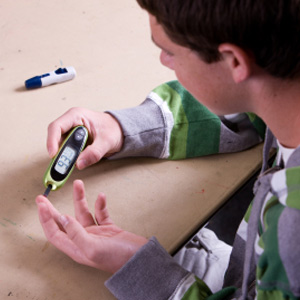
Experts at the American Diabetes Association are advising a lower blood sugar target for children and teens with type 1 diabetes.
According to the ADA, patients younger than age 19 should try to maintain an A1C blood sugar level lower than 7.5 percent, the group said in a new position statement.
A1C is a test that determines average blood sugar (glucose) levels over several months.
New guidelines
"The new targets should help redouble efforts at improving glucose control in the patient group that is currently most challenging – adolescents," said Dr. Robert Rapaport, director of the division of paediatric endocrinology and diabetes at Kravis Children's Hospital at Mount Sinai, New York City. He was not involved in drawing up the new guidelines.
In type 1 diabetes, the body can't produce enough insulin to convert food into energy, and people with type 1 diabetes must take insulin to survive.
Read more: Diabetes: type 1
Previously recommended A1C levels could be as high as 8.5 percent for children younger than 6 years, 8 percent for those ages 6 to 12, and 7.5 percent for those ages 13 to 19. These higher targets were set due to concerns about complications caused by a sometimes dangerous condition known as low blood sugar, or hypoglycaemia.
However, recent research shows that prolonged high blood sugar levels– hyperglycaemia – can lead to the development of serious complications in children, including heart and kidney disease. Previously, it had been thought that these complications occurred only in adults.
The targets for blood sugar control have therefore been ratcheted a bit downwards, the ADA explained.
Prolonged hyperglycaemia
The new blood sugar target for youngsters with type 1 diabetes, which was released at the ADA's annual meeting in San Francisco, matches the guidelines of the International Society for Paediatric and Adolescent Diabetes.
"The evidence shows that there is a greater risk of harm from prolonged hyperglycaemia that would occur if children maintained an A1C of 8.5 percent over time," statement co-lead author Dr. Jane Chiang, the ADA's senior vice president for medical and community affairs, said in an association news release.
"This is not to say we are no longer concerned about hypoglycaemia, but we now have better tools to monitor for hypoglycaemia," she added.
While the new 7.5 percent target is based on evidence from respected studies, "we want to emphasize that blood glucose and A1C targets must be individualised to safely achieve the best outcomes," Chiang added.
Experts agreed with that stance.
Risks of hypoglycaemia
"Considering the risk of hypoglycaemia in the young children, the management should be personalised," said Dr. Siham Accacha, director of the paediatric diabetes programme at Winthrop-University Hospital in Mineola, New York. "More than any other condition, treating children with diabetes requires special consideration," he said.
He and Rapaport agreed that the advent of better medications and medical technologies mean that hypoglycaemia is somewhat less of a risk than it was in the past. Those advances include sophisticated insulin pumps and "glucose sensors that have the ability to more quickly recognise high, as well as low, glucose levels," Rapaport explained.
Coupled with educating young patients about the risks of hypoglycaemia, these advances "may help diminish the incidence of severe hypoglycaemia and, at the same time, allow children and adolescents to reach their target goal with less difficulty," Accacha said.
Read: Hypoglycaemia and what to do about it
"Type 1 diabetes requires intensive insulin management that differs from how type 2 is managed," statement co-author Dr. Anne Peters, a professor at Keck Medicine at the University of Southern California, said in the ADA news release.
"People with type 1 require more supplies and must monitor their blood glucose levels more often. This is not a one-size-fits-all disease, and it's important that we recognise that," she added.
Read more:
Controlling type 1 diabetes
Storytelling time for kids with diabetes
Diabetes in kids to double




 Publications
Publications
 Partners
Partners











